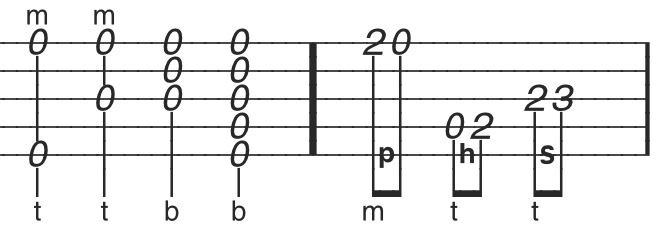| FREE
BANJO LESSONS - by Bradley Laird

LESSON
6
Reading Tablature
This banjo course uses tablature to communicate the music. Tablature (tab for
short) is a graphical chart which shows you:
a) which string to pick
b) which right hand finger does the picking
c) which fret to place your left hand finger behind to create a
note
d) the timing and order of the notes
e) notations indicating left hand techniques like slides and pull-offs
f) the chords which are used to "back up" the song
The five horizontal lines represent the five strings on the banjo.
The top line is your 1st string and they count down to the 5th
string (the short string) which is the bottom
line.

FIGURE
1
Vertical lines divide the tab into measures. Each measure gets
a certain number of beats. In this case 4 beats. All measures
are the same length
of time.
Notes are indicated
by placing a number on the string line. The "t
i m" markings indicate which right hand finger plucks the string.
The numbers tell you where the left hand fingers should fret a particular
string to create the note.
The second measure in Figure 1 above shows four notes. They
are not fretted, but rather are called "open" notes
which are indicated by a zero. You would play the 3rd string
with the thumb,
the 2nd string with the index finger, the 1st string with the middle
finger, and the 5th string with the thumb.
The third measure in Figure 1 shows some open and fretted notes. The
2nd note of that measure shows the 3rd string being picked by the
thumb
of the
right hand while a left hand finger "frets" the note
at the second fret. When fretting a note the fingertip is placed
just behind
the indicated fret and pressed firmly down. This effectively shortens
the length of the string which raises its pitch. There is no indication
of which left hand finger does the fretting.
Throughout the
lessons there will be notes in the text concerning which finger does
the fretting.
But, eventually you will be able to determine this on your own.

Timing and Counting
As was stated earlier, each measure has the same number of beats.
In these examples there are 4 beats per measure. The first
measure in Figure 2 below
shows a series of 4 quarter notes. A quarter note has a "stem" but
is not connected to the note next to it. Each quarter note gets
one beat. You would count the first measure as "1 2 3 4" with
a note sounding on each count.

FIGURE 2
The second measure in Figure 2 shows a series of eighth notes. Each eigth note
is half the length of a quarter note, therefore 2 eighth notes equals
one quarter note. The second measure would be counted as " 1 & 2 & 3 & 4 &" with
a note being picked on each half beat. Eighth notes are connected
with a horizontal line. Lone eighth notes have a "flag" attached
to their stem.
Measure three shows in Figure 2 a combination of quarter notes (1 beat)
and eighth notes (1 half beat) and would be counted as "1
2 & 3 4 &".
Measure four is a different combination of quarters and eighths.
It is counted as "
1 2 & 3 & 4".
Other Markings in Tab
When two notes are sounded together the right hand picking fingers
are indicated by placing a letter below and above the notes. These
notes are picked simultaneously. When the letter "b" is
shown it indicates a brush. A brush is done by playing across all
of the
indicated strings with one downward stroke of the thumb pick.

FIGURE 3 Other special techniques are indicated by the letter p, h and s. These
indicate pull-offs, hammer-ons, or slides. These are covered in detail
later.
Continue to Lesson 7.
All of my banjo books are downloadable eBooks. Get 'em today!
Free DHTML scripts provided
by
Dynamic Drive
|





